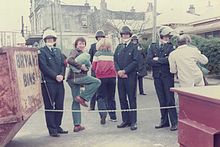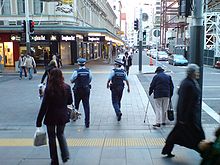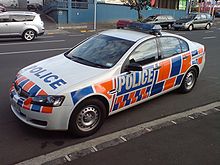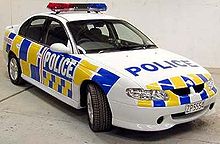- New Zealand Police
-
New Zealand Police
Ngā Pirihimana o Aotearoa (Māori)Logo of the New Zealand Police. Motto Safer Communities Together Agency overview Formed 1842 Preceding agencies - 1842 - 1886 known as the New Zealand Armed Constabulary or Armed Constabulary Force
- 1886 - 1958 known as the New Zealand Police Force
Employees 11,413 (30 June 2008) Legal personality Governmental: Government agency Jurisdictional structure National agency New Zealand Governing body New Zealand Government Constituting instruments - Police Act 1886
- Police Act 1958
- Policing Act 2008
General nature Operational structure Headquarters Wellington, New Zealand Sworn members 8,453 (30 June 2008) Unsworn members 2,960 (30 June 2008) Minister responsible Judith Collins, Minister of Police Agency executive Peter Marshall, Commissioner of Police Services 31- 111 Emergency
- Armed Offenders Squad
- Beat and patrol
- Counter Terror
- Criminal investigation
- Diplomatic Protection Squad
- Dive
- Diversion
- Dogs
- Drugs
- E-Crime
- EM-Bail
- Ethnic
- Evaluation
- Financial
- Fingerprint
- Firearms
- Forensics
- Info4traders
- Interpol
- Licensing
- Maritime
- Missing persons
- Museum
- International
- Road Policing
- Search & rescue
- Statistics
- Tenders
- Vetting
- Youth education
Districts 12- Northland
- Waitematā
- Auckland City
- Counties Manukau
- Waikato
- Bay of Plenty
- Eastern
- Central
- Wellington
- Tasman
- Canterbury
- Southern
Facilities Stations 400+ Website http://www.police.govt.nz/ The New Zealand Police (Māori: Ngā Pirihimana o Aotearoa, lit. The Policemen of New Zealand) is the national police force of New Zealand, responsible for enforcing criminal law, enhancing public safety, maintaining order and keeping the peace throughout New Zealand. With over 11,000 staff it is the largest law enforcement agency in New Zealand, and with few exceptions has primary jurisdiction over the majority of New Zealand criminal law.
The New Zealand police also has responsibility for traffic and commercial vehicle enforcement as well as other key responsibilities including dignitary protection, firearms licensing and matters of national security.
The current Minister of Police is the Hon. Judith Collins.
Contents
Origins and history
Policing in New Zealand started in 1840 with the arrival of six constables accompanying Lt. Governor Hobson's official landing party to form the colony of New Zealand. Early policing arrangements were along similar lines to the UK and British colonial police forces, in particular the Royal Irish Constabulary and the New South Wales Police Force. Many of its first officers had seen prior service in either Ireland or Australia. The early Force was initially part police and part militia.
At the outset, official establishment of sworn constables holding common law powers to arrest people was achieved by magistrates being given the power to swear them in via the Magistrates Ordinance of 1842. By 1846 the emerging organisation of a police force was recognised with the passage of the Armed Constabulary Ordinance. New Zealand's early police force continued to grow with the colony, and was further enhanced with additional structure and rules with the passage of the first Police Act, the New Zealand Armed Constabulary Act of 1867. The Armed Constabulary took part in land wars against Māori opposed to colonial expansion at that time.
From the police force's beginnings in 1840 through the next forty years, policing arrangements varied around New Zealand. Whilst the nationally organised Armed Constabulary split its efforts between regular law enforcement functions and militia support to the Maori land wars, some provinces desired local police forces of their own. This led to a separate Provincial Police Force Act being passed by the Parliament. However, provincial policing models lasted only two decades as economic depression in the 1870s saw some provinces stop paying their police as they ran out of money. Eventually, government decided a single nationally organised police would be the best and most efficient policing arrangement.
The New Zealand Police Force was established as a single national force under the Police Force Act of 1886. The change in name was significant, and provincial policing arrangements were dis-established and their staff largely absorbed into the newly created New Zealand Police Force. At the same time, government took the important step to hive off the militia functions of the old Armed Constabulary, and form the genesis of today's New Zealand Defence Force, initially called in 1886 the New Zealand Permanent Militia.
Just a decade later, policing in New Zealand was given a significant overhaul. In 1898 there was a very constructive Royal Commission of Enquiry into New Zealand Police. The Royal Commission, which included the reforming Commissioner Tunbridge who had come from the Metropolitan Police in London, produced a far reaching report which laid the basis for positive reform of New Zealand Police for the next several decades. A complete review of Police's legislation in 1908 built significantly off the Royal Commission's work.
A further Police Force Act in 1947 reflected some changes of a growing New Zealand, and a country coming out of World War II. But the most significant change in the structure and arrangement for Police was to arrive after the departure of Commissioner Compton under a cloud of government and public concern over his management of Police in 1955. The appointment of a caretaker civilian leader of Police, especially titled "Controller General" to recognise his non-operational background, opened the windows on the organisation and allowed a period of positive and constructive development to take place.
In 1958, the word "Force" was removed from the name when legislation was significantly revised.
On 1 July 1992, the Traffic Safety Service of the Ministry of Transport was merged with the Police. Up until that time, the Ministry of Transport and local councils had been responsible for traffic law enforcement. In 2001, the Police re-established a specialist road policing branch known as the Highway Patrol. Today the Police are responsible for enforcing traffic law, while local councils enforce parking regulations.[1] In 2010, after some calls to split traffic enforcement again from standard police duties, it was decided that it would remain part of their duties, partly due to the public having shown "enormous support" for it remaining this way.[2]
The Police Act 1958 was extensively reviewed starting in 2006, after a two and a half year consultative process the Policing Act 2008 came into effect on 1 October 2008.[3][4] The process included the world's first use of a wiki to allow the public to submit/propose amendments. The wiki was open for less than two weeks, but drew international attention.[5]
Notable policing events
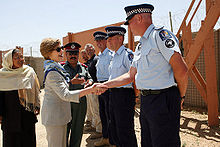 Laura Bush, First Lady of the United States in this 2008 photo, meeting New Zealand Police officers in Bamyan, Afghanistan
Laura Bush, First Lady of the United States in this 2008 photo, meeting New Zealand Police officers in Bamyan, Afghanistan
During the 1981 Springbok tour, the Police formed two riot squads known as Red Squad and Blue Squad to control anti-apartheid protesters who laid siege to rugby union fields where the touring team was playing.[6]
In July 1985, the New Zealand Police arrested two French Security Service operatives after the Rainbow Warrior was bombed and sunk in Auckland harbour. The rapid arrest was attributed to the high level of public support for the investigation.[7]
A member of the New Zealand Police, Sergeant Stewart Graeme Guthrie, was the last civilian recipient of the George Cross, which is awarded for conspicuous gallantry. He fired a warning shot near a gunman at Aramoana on 13 November 1990, but was killed by a return shot from the gunman, who also killed twelve others.[8]
More recently, the New Zealand Police has been involved in international policing and peacekeeping missions to East Timor and the Solomon Islands, to assist these countries with establishing law and order after civil unrest. They have also been involved in Community Police training in Bougainville, in conjunction with Australian Federal Police. Other overseas deployments for regional assistance and relief have been to Afghanistan as part of the reconstruction effort, the Kingdom of Tonga, Thailand for the tsunami disaster and Indonesia after terrorist bombings. New Zealand Police maintains an international policing support network in eight foreign capitals, and has about 80 staff deployed in differing international missions.[9]
At least 17 people were arrested in a series of raids under the Suppression of Terrorism Act and the Arms Act 1983 on 15 October 2007. The raids targeted a range of political activists allegedly involved in illegal firearms activity.[10]
Killed on duty
As of May 2009[update], 29 police officers have been killed by criminal acts, and about 17 by accident, while in the performance of their official duties.[11][12][13] The last policeman to die was Senior Constable Len Snee, who was shot and killed by Jan Molenaar in the 2009 Napier shootings.[14]
Equipment
New Zealand Police officers do not normally carry firearms while on patrol, but routinely carry pepper spray and batons. Tasers fitted with cameras were introduced following a decision by Commissioner Broad in August 2008 as an additional non-lethal weapon.[15] However, non-commissioned officers and specialist officers such as dog handlers and crime squad detectives often have a secure container within their police vehicle containing firearms; usually Glock 17 pistols as well as Bushmaster M4A3 XM15 carbines. [16][17] Weapons may be issued to front line staff in an armed response to a serious incident under the supervision of a senior officer. An armed response by police to an incident will often be considered a newsworthy event by the media.
In 1964, the Armed Offenders Squad (AOS) was created to provide a specialist armed response unit, similar to CO19 in the United Kingdom.
In addition to the AOS, the New Zealand Police maintain a full-time counter-terrorist unit, the Special Tactics Group (STG). Similar to the FBI's Hostage Rescue Team, the STG train in dynamic entry and other tactics vital in high-risk situations. The STG train with the SAS and are the last line of law enforcement response available before a police Incident Controller calls in support from the Military.
Counter-terrorism and military assistance
The NZ Police are accountable for the operational response to threats to national security, including terrorism. If an incident escalates to a level where their internal resources are unable to adequately deal with the issue (for example, a major arms encounter or a significant terrorist threat), the Police Incident Controller may call on extra assistance from the New Zealand Defence Force and in particular NZ's Special Forces, the military focused Special Air Service and terrorism focused CTTAG (Counter Terrorist Tactical Assault Group). Control of the incident remains with police throughout. As of 2009, the two military counter terrorist units have never been deployed in a domestic law-enforcement operation. Military resources such as Light Armoured Vehicles have been used and requested before, such as during the 2009 Napier Siege, and Royal New Zealand Air Force aircraft are often used to assist in search and rescue and cannabis eradication operations.
Organisation
Although headed by a Commissioner, the New Zealand Police is a decentralised organisation divided into twelve districts, each with a geographical area of responsibility, three communications centres that each receive calls from *555 traffic, 111 emergency or general queues, and a Police National Headquarters that provides policy and planning advice as well as national oversight and management of the organisation.
District Commanders hold the rank of Superintendent, as do sworn National Managers, the road policing manager in the Waitemata District, responsible for the motorway network and traffic alcohol group, and the commandant of the Royal New Zealand Police College. Area Commanders hold the rank of Inspector as do Shift Commanders based in each of the three Communications Centres. District Section Commanders are typically Senior Sergeants. The New Zealand Police is a member of Interpol and has close relationships with the Australian police forces, at both the state and federal level. Several New Zealand Police representatives are posted overseas in key New Zealand diplomatic missions.
The Police also work closely with the Serious Fraud Office.
Staff
While sworn officers make up the majority of the workforce, non-sworn staff and volunteers provide a wide range of support services where a sworn officer's statutory powers are not required.
Ranks
Rank insignia is worn on the epaulettes. Officers of Inspector rank and higher are commissioned by the Governor General, but are still promotions from the ranks of non-commissioned officers.
Rank Insignia Insignia description Military equivalent[18] Percentage
of officers[18]Commissioner silver crossed sword and baton below a crown Lieutenant General 5% Deputy Commissioner silver crossed sword and baton below one star ("pip") Major General Assistant Commissioner three silver pips in a triangle below a crown Brigadier Superintendent one silver pip below a crown Lieutenant Colonel Inspector three silver pips Captain Senior Sergeant white crown between two ferns above police number Warrant Officer 5% Sergeant three white point-up chevrons above police number Sergeant 15% Senior Constable one white point-up chevron above police number 75% Constable police number Private Recruit word "RECRUIT" below police number A recently graduated Constable is considered a Probationary Constable for up to two years, until he or she has passed ten workplace assessment standards and a compulsory university paper. The completion of the above is known as obtaining permanent appointment.
Detective ranks somewhat parallel the street ranks up to Detective Superintendent. Trainee Detectives spend around 6–12 months time as a Constable on Trial after completing an intensive Selection and Induction course, before progression to Detective Constable after successful completion of several training modules. There is then a Workplace assessment for Detective Constables, and after approximately 2–3 years in the Criminal Investigation Branch, a Detective Constable may take the pre-requisite examination and qualifying course to become a Detective.
The rank of Senior Constable is granted to Constables after 14 years of service and the Commissioner of Police is satisfied with their conduct. Senior Constables are well regarded within the New Zealand Police for their extensive policing experience, and are often used to train and mentor other police officers.
Detective and Detective Constable are considered designations and not specific ranks. That is, Detectives do not outrank uniformed constables. Although, a police officer with a Detective designation will generally assume control of a serious crime scene rather than a uniform staff member regardless of rank.
New Zealand police uniforms formerly followed the British model closely but since the 1970s a number of changes have been implemented. These include the adoption of a medium blue shade in place of dark blue, the abolition of custodian helmets and the substitution of synthetic leather jackets for silver buttoned tunics when on ordinary duty. AOS and STG members, when deployed, wear the usual charcoal-coloured clothing used by armed-response and counter-terror units around the world. In 2008, a survey found strong staff support for the re-introduction of custodian helmets to reinforce the police's professional image.[19]
Training and educational change
Under new management, in early 2009 the Royal New Zealand Police College embarked upon an assessment of its quality, purpose and personnel. This assessment led to the initiation of a programme of change. Within the programme are multiple projects, managed via four work streams addressing change in the areas of:
- Strategy & Growth
- Business Planning & Performance
- Learning Pathways
- Technology Assisted Learning
By September 2009, the programme had submitted a restructure to the organisation through formal consultation. By November 2009, 400 formal submissions were recorded.
Transport
The Holden Commodore is the current generic vehicle of choice for the Police - in the past they have used Ford Falcons and the Nissan Maxima. The highway patrol mainly uses the Holden Commodore S variant. Also the police currently use unmarked models of the Toyota Camry, Subaru Legacy, Holden Commodore and Hyundai Sonata. Also, Holden Rodeo utility vehicles and Holden Captiva's are used in rural areas. Liveries are checkered Battenburg markings orange-blue (general duties) or yellow-blue (highway patrol), as well as cars in standard factory colours. Since 2008 the orange-blue livery is being phased out, and all marked patrol vehicles are expected to have the yellow-blue livery as well as LED light bars by 2014.[20] Both Commodore sedan and wagon bodies are used - normally in V6 form and optionally with an LPG tank fitted.
Dog handlers have fully enclosed utility or station wagon vehicles, which may be liveried or unmarked, with cages in the rear and remotely operated canopy doors to allow the handler to release their dog if away from the vehicle.
The police operate one dedicated air unit - the Eagle helicopter in Auckland (an Aérospatiale AS355),[21] and two maritime units - the launch Deodar III and four smaller vessels in Auckland, and the launch Lady Elizabeth IV in Wellington.[22]
Accountabilities
While the New Zealand Police is technically a government department and has political representation in Government through the Minister of Police, the Commissioner and all sworn members swear allegiance directly to the Sovereign and, by constitutional convention, have constabulary independence from the government of the day.
Crime statistics
In addition to the annual report, the Police also publishes six-monthly statistical summaries of crime for both New Zealand as a whole and each Police District. In early 2005, crime statistics for both Recorded Crime and Recorded Apprehensions for the last 10 years were published by Statistics New Zealand. These statistics provide offence statistics down to individual sections of legislation and appear to be the most detailed national crime statistics available today.
Recent controversies
The New Zealand Police is considered one of the least corrupt police forces in the world.[23] Despite this, there have been a number of recent controversies that have put the Police under close scrutiny. While the Police Complaints Authority is an independent body that investigates complaints against the New Zealand Police, the following events have either fallen outside the authority's ambit or received significant publicity.
Historic sexual misconduct
In 2004, a number of historic sexual misconduct allegations dating from the 1980s were made against both serving and former police officers.
In March 2006 assistant police commissioner Clinton Rickards and former police officers Brad Shipton and Bob Schollum were charged with raping and sexually abusing Louise Nicholas in Rotorua during the 1980s. The defendants claimed all sex was consensual and all were found not guilty on 31 March 2006.[24][25] In February 2007 the same three men faced historic charges of kidnapping and indecent assault for the pack rape of a 16-year-old girl with a whisky bottle that took place in the early 1980s, and again they were acquitted. Information that had been kept from both juries (but was widely distributed following the 2006 not guilty verdicts) was then allowed to be publicly released: Brad Shipton and Bob Schollum were convicted in 2005 of another historic pack rape with an object and are currently serving lengthy prison sentences for this crime.[26] Rickards subsequently resigned from the police.[27]
Communications centres
New Zealand Police operate a system of three Communications Centres across the country:
- Northern Communications Centre, based in Auckland and responsible for the northern half of the North Island, from Cape Reianga in the North to Hicks Bay, Desert Rd south of Turangi, and Awakino in the South.
- Central Communications Centre, based in Wellington and responsible for the southern half of the North Island, from Mokau, Taumarunui, Desert Rd north of Waiouru, and Te Araroa in the North to Wellington in the South.
- Southern Communications Centre, based in Christchurch, responsible for the entire South Island.[28]
Together the three centres receive and dispatch 111-emergency calls and general calls for service.
In 2004 and 2005, the police were criticised over several incidents in which callers to the Police Communications Centres, particularly those using the 111 emergency telephone number, are alleged to have received inadequate responses.
In October 2004, under sustained political scrutiny for these apparent systemic problems in the Communications Centres, and after the Iraena Asher incident received a lot of publicity and a whistle-blowing employee resigned, the Commissioner of Police ordered an Independent Review into the Communications Centres. On 11 May 2005, the Review Panel released a report into the service [29] which criticised the service for systemic failures and inadequate management, and expressed ongoing concerns for public safety.
Police acted on the recommendations of the review with a number of initiatives, including increasing communications centre staff numbers [30] and then initiating a demonstration project for a future "Single Non-Emergency Number" (SNEN) [31][32][33] centre, to reduce the load on the 111 service.
Police culture
An investigation into "Police Culture" reported on 10 October 2005 that while the defunct Emergency Response Group at Counties-Manukau used excessive force and took inappropriate and degrading photographs of people in custody, there was no nationwide problem with police culture.[34] In a subsequent investigation into police culture by Margaret Bazley, she reported several elements of the problem police culture. These include strong bonding among colleagues, bad attitudes toward the use of alcohol, particularly when off duty, as well as a male-oriented culture. [35]
Taser trial
See also: Taser controversyThe New Zealand Police taser trial commenced on Friday 1 September 2006 for a twelve month period.[36] Some opposition to the trial has been expressed by various people, including Māori Party police spokesperson Hone Harawira, Green party police spokesperson, Keith Locke,[37] and several high profile individuals including Barrister, Marie Dyhrberg and Sir Paul Reeves who have formed a lobby group opposing their use.[38] The first person to be tasered was an 18 year old after an incident in the Auckland suburb of Western Springs on 8 September 2006.[39]
Since the completion of the trial it has been revealed that even if the taser is approved it is unlikely that every frontline officer would be equipped with a taser.[40] Tasers are likely to be issued in 2009, and the Commissioner has made recommendations in the 2009 budget to equip the remaining 8 Districts.[citation needed]
See also
- Armed Offenders Squad
- Crime in New Zealand
- Crimes Act 1961
- Diplomatic Protection Squad
- Organised Crime Agency
- Royal New Zealand Police College
- Special Tactics Group
- Institute of Environmental Science and Research - provider of forensic services to NZ police.
References
- ^ "Summary of review findings of de-merging traffic enforcement from Police". State Services Commission. 26 April 2007. http://www.ssc.govt.nz/display/document.asp?docid=6081.
- ^ "Police remain on traffic duty". The New Zealand Herald. 28 February 2010. http://www.nzherald.co.nz/nz/news/article.cfm?c_id=1&objectid=10628975. Retrieved 3 March 2010.
- ^ "Policing Act 2008 No 72, Public Act - Commencement". Parliamentary Counsel Office. http://www.legislation.govt.nz/act/public/2008/0072/latest/DLM1564700.html?search=ts_act_policing. Retrieved 2008-10-02.
- ^ [1]
- ^ "NZ police let public write laws". BBC News. 26 September 2007. http://news.bbc.co.uk/2/hi/asia-pacific/7015024.stm. Retrieved 2007-10-04.
- ^ Utting, Peter (October 2004). "Lessons from the Movements of Australia and New Zealand". Conference on International Anti-Apartheid Movements in South Africa's Freedom Struggle: Lessons for Today. http://www.anc.org.za/un/conference/putting.html.
- ^ "Rainbow Warrior bombing, 1985". New Zealand Police. http://www.police.govt.nz/operation/wharf/.
- ^ London Gazette: (Supplement) no. 52837. pp. 2783–2784. 17 February 1992. Retrieved 2008-04-09.
- ^ "FAQ about New Zealand Police overseas, International Service Group". New Zealand Police. http://www.police.govt.nz/service/overseas/faq.html.
- ^ "Exclusive: Hunters alerted police to alleged terror camps". The New Zealand Herald. 15 October 2007. http://www.nzherald.co.nz/section/1/story.cfm?c_id=1&objectid=10469938&pnum=0. Retrieved 2007-10-15.
- ^ Memorial - New Zealand Police
- ^ "Two questioned after policeman chased, shot dead". The New Zealand Herald. 11 September 2008. http://www.nzherald.co.nz/section/1/story.cfm?c_id=1&objectid=10531643.
- ^ "Three officers shot at, one killed - report". The New Zealand Herald. 7 May 2009. http://www.nzherald.co.nz/nz/news/article.cfm?c_id=1&objectid=10570929. Retrieved 2009-05-06.
- ^ "Officer's body recovered". The Press. 8 May 2009. http://www.stuff.co.nz/the-press/news/2394558/Napier-siege-continues. Retrieved 2009-05-10.
- ^ Gower, Patrick (28 August 2008). "Broad confirms Taser introduction". The New Zealand Herald. http://www.nzherald.co.nz/section/1/story.cfm?c_id=1&objectid=10529437. Retrieved 2008-08-30.
- ^ Senior police carrying up to six firearms
- ^ Annual Report for the year ended 30 June 2005 - New Zealand Police
- ^ a b "Insignia". New Zealand Police. http://www.police.govt.nz/about/insignia.html. Retrieved 2009-09-01.
- ^ McNaughton, Maggie (5 February 2008). "Police beanies get OK, helmets must wait". The New Zealand Herald. http://www.nzherald.co.nz/nz/news/article.cfm?c_id=1&objectid=10490672. Retrieved 30 October 2011.
- ^ Binning, Elizabeth (11 November 2008). "Arresting image update to save police force $800,000". The New Zealand Herald. http://www.nzherald.co.nz/nz-police/news/article.cfm?o_id=131&objectid=10542312. Retrieved 2009-03-23.
- ^ "Air Support "Eagle" Unit (Auckland)". New Zealand Police. http://www.police.govt.nz/service/airsupport/. Retrieved 2009-06-21.
- ^ "Maritime Unit". New Zealand Police. http://www.police.govt.nz/service/maritime/. Retrieved 2009-06-21.
- ^ "Living in New Zealand - A guide for migrants - The New Zealand Police". Immigration New Zealand. http://www.immigration.govt.nz/migrant/settlementpack/Government/TheNZPolice/.
- ^ "Rickards rape trial accuser to take stand". The New Zealand Herald. 14 March 2006. http://www.nzherald.co.nz/nz/news/article.cfm?c_id=1&objectid=10372534. Retrieved 30 October 2011.
- ^ "Jury clears men in police rape trial". The New Zealand Herald. 31 March 2006. http://www.nzherald.co.nz/nz/news/article.cfm?c_id=1&objectid=10375376. Retrieved 30 October 2011.
- ^ "Police sex trial: What the jury never knew". The New Zealand Herald. NZPA. 1 March 2007. http://www.nzherald.co.nz/nz/news/article.cfm?c_id=1&objectid=10426475. Retrieved 30 October 2011.
- ^ Taylor, Phil (20 November 2008). "Police paid Rickards $300,000 to leave". The New Zealand Herald. http://www.nzherald.co.nz/nz/news/article.cfm?c_id=1&objectid=10544044.
- ^ http://www.police.govt.nz/service/commscentres/index.html
- ^ Communications Centres Service Centre Independent External Review Final Report - New Zealand Police
- ^ Ten-One: Comms Centres boost staff numbers - New Zealand Police
- ^ Ten-One: Countdown to SNEN lift-off
- ^ Ten-One: SNEN – What is it and why are we doing it?
- ^ Ten-One: SNEN Centre Manager appointed
- ^ Binning, Elizabeth (12 October 2005). "New cases of police abuse in spotlight". The New Zealand Herald. http://www.nzherald.co.nz/police-culture/news/article.cfm?c_id=1500913&objectid=10349834. Retrieved 30 October 2011.
- ^ Bridgman, T. Leading culture change in NZ Police. Australia and NZ School of Government Case Program, 2008-82.1.
- ^ Tasers on the streets from this Friday, Derek Cheng, New Zealand Herald, 30 August 2006
- ^ Police too eager to use taser, Keith Locke, Green Party website 10 September 2006
- ^ Cheng, Derek (7 June 2006). "Opponents fear abuse of stun gun". The New Zealand Herald. http://www.nzherald.co.nz/campaign-against-the-taser/news/article.cfm?o_id=600630&objectid=10385354. Retrieved 30 October 2011.
- ^ Cleave, Louisa (11 September 2006). "Police right to use Taser on drinking nephew, says aunt". The New Zealand Herald. http://www.nzherald.co.nz/nz/news/article.cfm?c_id=1&objectid=10400730. Retrieved 2009-04-16.
- ^ "Taser trial". New Zealand Police. http://www.police.govt.nz/resources/2006/taser-trial/.
External links
- New Zealand Police
- New Zealand Police - statistics
New Zealand Defence Force · New Zealand Security Intelligence Service · Office of the Clerk of the House of Representatives · Parliamentary Counsel Office · Parliamentary Service Commission · New Zealand PoliceLaw enforcement in Oceania Sovereign states - Australia
- East Timor (Timor-Leste)
- Fiji
- Indonesia
- Kiribati
- Marshall Islands
- Federated States of Micronesia
- Nauru
- New Zealand
- Palau
- Papua New Guinea
- Samoa
- Solomon Islands
- Tonga
- Tuvalu
- Vanuatu
Dependencies and
other territories- American Samoa
- Christmas Island
- Cocos (Keeling) Islands
- Cook Islands
- Easter Island
- French Polynesia
- Guam
- Hawaii
- New Caledonia
- Niue
- Norfolk Island
- Northern Mariana Islands
- Pitcairn Islands
- Tokelau
- Wallis and Futuna
Categories:- National law enforcement agencies of New Zealand
- Government agencies of New Zealand
- Law enforcement in New Zealand
- 1842 establishments in New Zealand
Wikimedia Foundation. 2010.


